This article was co-authored by Rajesh Khanna, MD. Dr. Rajesh Khanna is a board certified Ophthalmologist and the Founder of Khanna Vision Institute in Los Angeles, California. Dr. Khanna specializes in Lasik, cataract, and refractive eye surgery as well as treatments for presbyopia and keratoconus. Dr. Khanna completed his first Ophthalmology Residency in Mumbai and his second Ophthalmology Residency at SUNY Downstate in New York City. He went on to complete a fellowship training in corneal and refractive surgery from the University of Cincinnati in Ohio and a Neurophthalmology fellowship from Kingsbrook Jewish Hospital in New York City. Dr. Khanna is also a voluntary member of the UCLA faculty and is an Internationally recognized top Lasik, presbyopic implants in the eye (PIE), and Refractive vision care specialist. He is board certified by the American Board of Ophthalmology and is a certified Master of Surgery by the University of Bombay.
There are 8 references cited in this article, which can be found at the bottom of the page.
This article has been viewed 130,288 times.
Astigmatism is a common eye condition that causes blurry vision. It occurs when your cornea is more oblong, or football-shaped, than round. Astigmatism can be diagnosed by your optometrist or ophthalmologist with a comprehensive eye exam. It can be corrected with glasses, contacts, or sometimes surgery – but measuring the shape of your cornea is important for getting the right lens prescription. Astigmatism is usually measured with a series of eye exams, some that are standard practice and others that may apply only to certain circumstances.
Steps
Using the Standard Measurement Tools
-
1Perform the Visual Acuity Test. At your eye doctor’s office, stand where your doctor tells you and look at a chart of numbers and letters on the wall. Cover one eye and read the lines of text to the smallest line you can clearly read, then repeat this with your other eye covered. This tests for myopia (near-sightedness) and hyperopia (far-sightedness), as well as astigmatism.[1]
- Astigmatism accompanies myopia or hyperopia 50% of the time. Blurry vision could be caused by astigmatism or one of these other common conditions.
- The results will be listed as a fraction, such as 20/20. 20/20 is normal visual acuity. The first number is the distance between you and the chart. The second number is the size of the letters on the last line you can read compared to normal visual acuity. For instance, someone with 20/40 vision has to be 20 feet from something that can be read at 40 feet (12.2 m) by someone with normal vision.[2]
-
2Measure the curve of your cornea with a keratometer. A keratometer is the instrument your eye doctor can use to measure the curve of your anterior cornea (the front surface of the cornea).[3] Sit with your chin on the chin rest and look straight ahead into the instrument with one eye then the other, when prompted by your doctor. The keratometer shines a circle of light onto your cornea and measures how it reflects over your cornea’s surface.
- This is an especially important test for getting contact lenses that fit correctly.
- Though this method has its limitations, it’s still the standard way of measuring astigmatism.[4]
Advertisement -
3Use refraction to measure astigmatism. Sit up straight and look forward while your doctor places a retinoscope in front of your eyes. The retinoscope is a small, handheld instrument that measures light refraction on the eye. Your doctor will move a large machine with lenses (a phoropter) in front of your eyes that either clarify or obscure your vision, which measures how your eyes focus light. You will have to tell your doctor whether each lens makes your vision better or worse.[5]
- The refraction test helps to establish the location of the irregular shape of the cornea. This will be called the "axis" in a corrective lens prescription.
- Be honest with your doctor during these tests – even though technology is improving, your feedback still helps determine the outcomes of your eye exam.
-
4Understand your astigmatism prescription. After your eye exam, your doctor will give you a prescription for glasses or contact lenses to help fix your astigmatism. The prescription will usually have three numbers – the first one relates to if you’re near-sighted or far-sighted, and the last two relate to your astigmatism.[6]
- The second number is for “cylinder,” which is a measure of how flat or irregular your cornea is. This is measured in diopters. Most people with astigmatism have between 0.5-0.75 diopters; you probably need prescription lenses for a diopter measurement of 1.5 or higher.
- The third number is for “axis” and goes from 0 to 180, which is a degree measurement of where on your cornea the astigmatism is located.
Utilizing Other Measurement Options
-
1Use a corneal topographer for more precise measurements. A topographer is a newer version of the keratometer.[7] Your doctor will have you sit at a table and look into a bowl. This bowl's inner surface is covered in a pattern of concentric rings. A digital camera sits at the base of the bowl and charts the cornea's surface by measuring the reflected pattern in the eye. This basically creates a contour map of your eye, and it’s an excellent technique for measuring irregular astigmatism.[8]
- Most corneal topography tests measure 8,000 to 10,000 points on the cornea, making it the most accurate keratometry test.
- Other advanced ways of measuring astigmatism include autorefractors that measure refraction, and the IOLMaster that makes extensive measurements of the interior and exterior of the eye. The IOLMaster is usually used before cataract surgery.[9]
-
2Try a Placido disc for irregular astigmatism. The Placido disc is a hand-held device that is shaped like a giant lollipop. The disc has several sets of concentric circles painted on one side, and is used to measure the regularity of your cornea’s surface. Your doctor holds the disc up to their own eye with the rings pointed towards you, and they look into your eye. Sit still and look straight ahead. The image of your cornea reflects back, and where there is irregular shape it makes the concentric rings look distorted to your doctor.[10]
- This method can help to diagnose keratoconus, a disorder that causes irregular astigmatism due to thinning and protruding of the cornea.
- Your doctor may also use a modern instrument that has a light in the center. The disc is projected onto the cornea, and the doctor will analyze the reflection of the light on your cornea.[11]
-
3Use a Scheimpflug device to measure the posterior cornea. The shape of your posterior cornea (the back surface of the cornea) can influence the severity of your astigmatism.[12] Keratometry can only measure the front of your cornea, but Scheimpflug imaging uses tomography to get more accurate readings of how thick your cornea is and what the back of it looks like.[13]
- This method can be helpful in predicting how successful surgery may be in correcting your astigmatism.
Expert Q&A
Did you know you can get expert answers for this article?
Unlock expert answers by supporting wikiHow
-
QuestionWhat instruments are used for measuring astigmatism?
 Rajesh Khanna, MDDr. Rajesh Khanna is a board certified Ophthalmologist and the Founder of Khanna Vision Institute in Los Angeles, California. Dr. Khanna specializes in Lasik, cataract, and refractive eye surgery as well as treatments for presbyopia and keratoconus. Dr. Khanna completed his first Ophthalmology Residency in Mumbai and his second Ophthalmology Residency at SUNY Downstate in New York City. He went on to complete a fellowship training in corneal and refractive surgery from the University of Cincinnati in Ohio and a Neurophthalmology fellowship from Kingsbrook Jewish Hospital in New York City. Dr. Khanna is also a voluntary member of the UCLA faculty and is an Internationally recognized top Lasik, presbyopic implants in the eye (PIE), and Refractive vision care specialist. He is board certified by the American Board of Ophthalmology and is a certified Master of Surgery by the University of Bombay.
Rajesh Khanna, MDDr. Rajesh Khanna is a board certified Ophthalmologist and the Founder of Khanna Vision Institute in Los Angeles, California. Dr. Khanna specializes in Lasik, cataract, and refractive eye surgery as well as treatments for presbyopia and keratoconus. Dr. Khanna completed his first Ophthalmology Residency in Mumbai and his second Ophthalmology Residency at SUNY Downstate in New York City. He went on to complete a fellowship training in corneal and refractive surgery from the University of Cincinnati in Ohio and a Neurophthalmology fellowship from Kingsbrook Jewish Hospital in New York City. Dr. Khanna is also a voluntary member of the UCLA faculty and is an Internationally recognized top Lasik, presbyopic implants in the eye (PIE), and Refractive vision care specialist. He is board certified by the American Board of Ophthalmology and is a certified Master of Surgery by the University of Bombay.
Board Certified Ophthalmologist There are many different technologies to measure astigmatism. The most commonly used is a Placiso disc method where a light reflection is measured off the cornea. Newer technologies include the wavefront, which can measure astigmatism in other parts of the eye than just the cornea, and pachymetry, which measures the thickness over the different areas of the cornea.
There are many different technologies to measure astigmatism. The most commonly used is a Placiso disc method where a light reflection is measured off the cornea. Newer technologies include the wavefront, which can measure astigmatism in other parts of the eye than just the cornea, and pachymetry, which measures the thickness over the different areas of the cornea.
References
- ↑ https://medlineplus.gov/ency/article/003396.htm
- ↑ http://www.aoa.org/patients-and-public/eye-and-vision-problems/glossary-of-eye-and-vision-conditions/astigmatism?sso=y#2
- ↑ http://www.aoa.org/patients-and-public/eye-and-vision-problems/glossary-of-eye-and-vision-conditions/astigmatism?sso=y#2
- ↑ http://www.ophthalmologyweb.com/Tech-Spotlights/26530-Keratometry-Focusing-on-Astigmatism/
- ↑ http://www.aoa.org/patients-and-public/eye-and-vision-problems/glossary-of-eye-and-vision-conditions/astigmatism?sso=y#2
- ↑ https://www.aao.org/eye-health/diseases/what-do-astigmatism-measurements-mean
- ↑ http://www.aoa.org/patients-and-public/eye-and-vision-problems/glossary-of-eye-and-vision-conditions/astigmatism?sso=y#2
- ↑ http://www.ophthalmologyweb.com/Tech-Spotlights/26530-Keratometry-Focusing-on-Astigmatism/
- ↑ http://www.ophthalmologyweb.com/Tech-Spotlights/26530-Keratometry-Focusing-on-Astigmatism/
- ↑ Rajesh Khanna, MD. Board Certified Ophthalmologist. Expert Interview. 11 November 2020.
- ↑ Rajesh Khanna, MD. Board Certified Ophthalmologist. Expert Interview. 11 November 2020.
- ↑ https://www.ncbi.nlm.nih.gov/pubmed/25162757
- ↑ http://iovs.arvojournals.org/article.aspx?articleid=2212759
- ↑ http://www.mayoclinic.org/diseases-conditions/astigmatism/diagnosis-treatment/diagnosis/dxc-20253081
- ↑ https://www.aao.org/eye-health/diseases/what-do-astigmatism-measurements-mean
About This Article
Astigmatism is a common eye condition that makes your vision blurry. To measure the extent of your astigmatism, book an eye test with your local optometrist. They’ll guide you through a series of tests, using different apparatus. First, they’ll probably get you to read a simple chart to measure how far you can see clearly. They’ll also shine a small light in your eyes to measure the curve of your corneas. Then, your optometrist will get you to look through different lenses and tell them if they’re blurry or clear to check how your eyes focus light. If your astigmatism is significantly affecting your eyesight, you can correct it by wearing glasses or contact lenses. You may also be able to get laser eye surgery to permanently correct the problem. For more tips, including how your optometrist might measure your posterior cornea, read on.

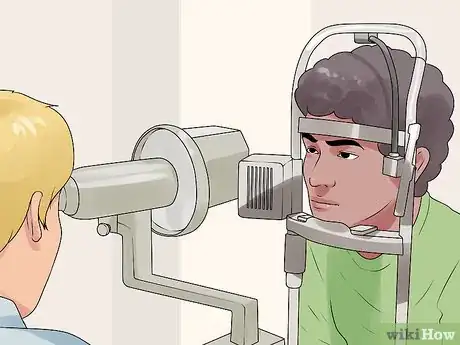
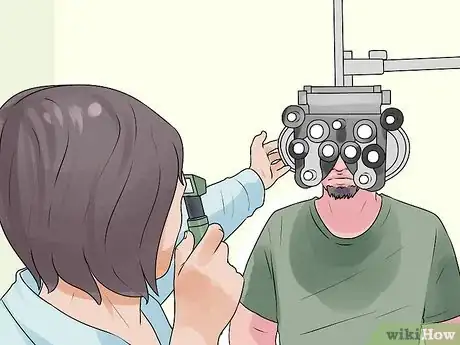
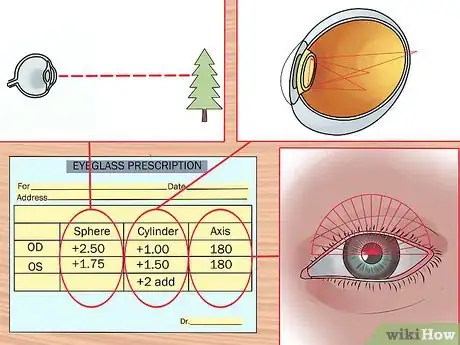

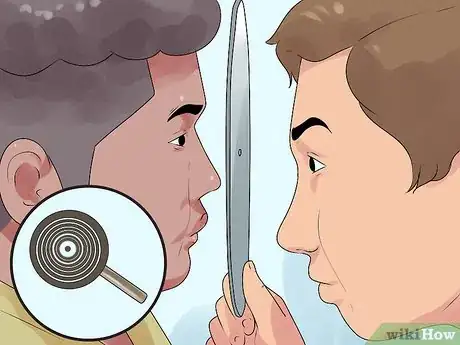

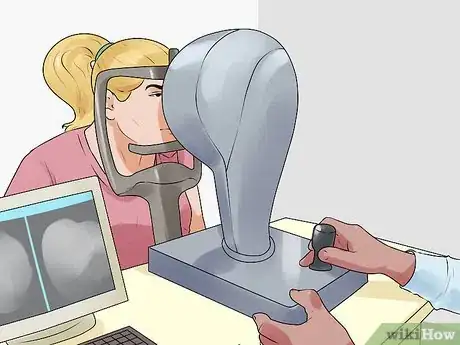

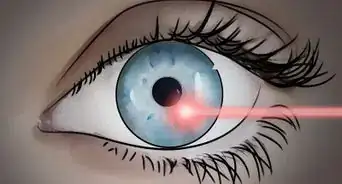



















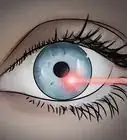





































Medical Disclaimer
The content of this article is not intended to be a substitute for professional medical advice, examination, diagnosis, or treatment. You should always contact your doctor or other qualified healthcare professional before starting, changing, or stopping any kind of health treatment.
Read More...